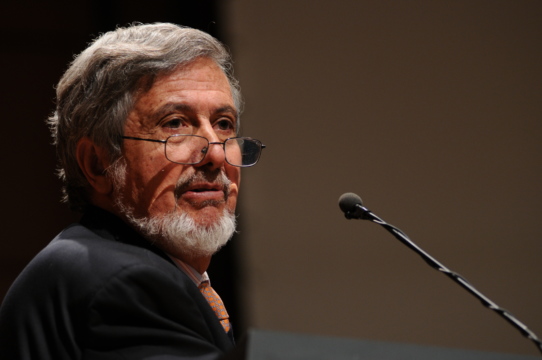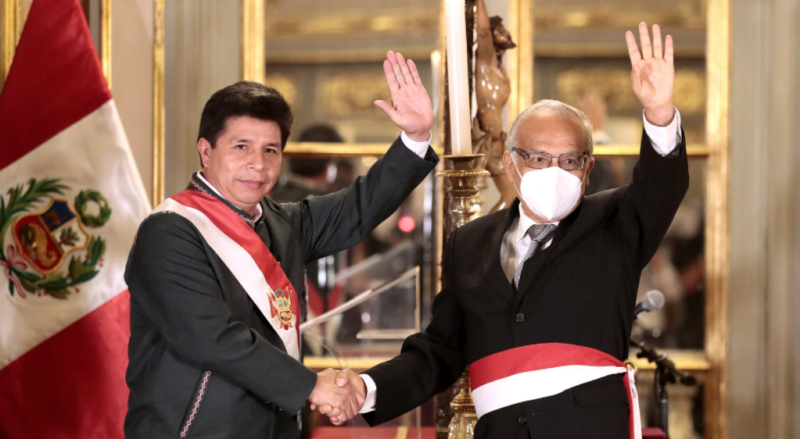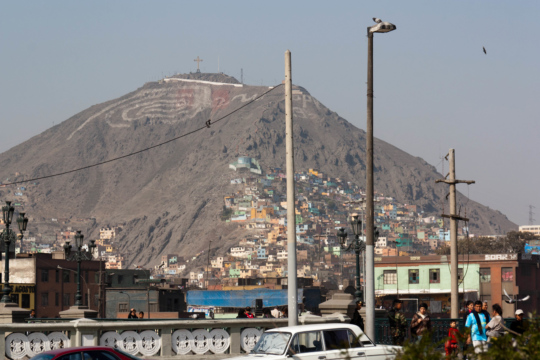
Impact of Lower Commodity Prices on Latin American Growth
With the recent decline in commodity prices, why have some countries have fared better than others?
A Daily Publication of The Dialogue
Peruvian President Pedro Castillo, who took office last July, on Tuesday swore in his fourth prime minister, former Justice Minister Aníbal Torres. Castillo’s last prime minister, Héctor Valer, resigned last week after just four days on the job amid domestic violence allegations, which he has denied. Castillo left Finance Minister Oscar Graham and Foreign Minister César Landa in their posts but named a new health minister, Hernán Condori. Why is there so much upheaval in Castillo’s administration, and what does he need to do in order to normalize it? What does the cabinet instability mean for Castillo’s policy agenda? To what extent does the instability in the cabinet foreshadow a potential early exit for Castillo himself before his term ends? How is the opposition-controlled Congress likely to act in relation to Castillo’s cabinet?
Augusto Álvarez-Rodrich, daily columnist on political affairs at La República: “With four cabinets in the first six months alone, a contradictory and directionless government and a political system rotted by the infiltration of mafias in all the powers of the state—including the presidency and the Congress—the Peruvian population is experiencing great uncertainty in a context of accelerated economic deterioration and the urgency of the challenge of defeating the pandemic. The Peruvian crisis is old, but it has worsened a lot in the last half year due to a president like Pedro Castillo, who makes ignorance a source of pride. He assures that he came to the presidency to learn, but each passing day confirms that he is a professor who does not learn anything and instead goes backwards. The origin of this crisis is Castillo, a demonstrably inept president who has squandered every opportunity to make amends during the first half of his presidency, leaving little hope that he will improve in the future. Every day, the consensus grows in Peru that it would be good for the country if President Castillo resigned in order to end this crisis, that Congress should too, and that the country should hold new elections. The growing consensus is for everyone to go. That does not guarantee that what comes will be better, but it does ensure that we get out of a situation that does not work for the people.”
Cynthia McClintock, professor of political science and international affairs at The George Washington University: “Peru’s political waters are more turbulent than ever, and Castillo’s ship is in grave danger. The cabinet appointed on Feb. 1 lasted only three days. In six months in office, Castillo will have named four prime ministers; he has made more cabinet changes in his first six months than any Peruvian president in at least 50 years. The consensus is that Castillo does not choose his ministers carefully. The prime minister named on Feb. 1, Héctor Valer, had been credibly accused of domestic abuse, among other crimes. Having been elected to Peru’s 2021 Congress for a far-right populist party, Valer was also a political opportunist. A large number of Castillo’s ministers had no meaningful experience in the sector that they were asked to lead, and a considerable number faced legal charges. Fears about Castillo’s incompetence have been heightened by his suggestion in an interview with CNN en Español that, upon a referendum, Peru could cede territory to Bolivia. Fears about Castillo’s ethics have been heightened by revelations of his irregular meetings with VIPs outside the presidential palace. In this context, Castillo will find it very difficult to recruit able ministers. The debate in Peru is turning to possible exits for Castillo. Not only Peru’s rightist parties, but also its centrist parties, are considering impeachment, which Congress can approve on a two-thirds vote on the grounds of ‘moral incapacity.’ Castillo would be succeeded by Vice President Dina Boluarte. However, after five years of executive-legislative conflict and various short-term presidents, there is awareness that, if widely perceived as unfair or incorrect, Castillo’s exit could be a cure worse than the disease. Castillo’s approval rating is now a tad below 30 percent; if it continues to fall, the debate about his exit will intensify.”
Mercedes Aráoz, senior professor of finance at the Universidad del Pacífico and former vice president of Peru: “Castillo reminds us of the tale of the Emperor’s New Clothes. The president is unable to see that he himself is causing this crisis in Peru. He removed allies of Nuevo Perú from his cabinet. Ministers are now making strong accusations of corruption, and a shadow cabinet didn’t allow his former prime minister, Mirtha Vásquez, to lead government policy. He then named Prime Minister Héctor Valer, a congressman who jumped from an ultraconservative party to a leftist group led by Congressman Guillermo Bermejo, who also resigned from Peru Libre, the government party. Not only did Valer have bad political credentials, he has been accused of domestic violence. The new members of the cabinet presented neither the credentials, nor the capabilities or reputation. So, another crisis developed, and a fourth cabinet—in less than seven months—has to take shape. What Castillo apparently wanted was to generate a response from Congress denying a vote of confidence in the Valer cabinet and, as Valer said, use his silver bullet and risk Congress being dissolved. Castillo is unable to recognize his mistakes and is pointing to political rivals and the press as the causes of the crisis. Many voices beyond his usual opposition are saying it is time for President Castillo to step down. The instability is triggering a profound damage in the governance and economy of Peru. People in the streets are shouting that the emperor has no clothes, and the emperor is not listening.”
Katya Rimkunas, regional deputy director for Latin America and the Caribbean at the International Republican Institute: “While Peruvians are familiar with political turmoil and instability, Castillo’s start is challenging their comfort levels. From the moment he won the election, many predicted the obstacles and challenges Castillo would face in governing and advancing his agenda. Despite Castillo’s Free Peru party having the largest number of seats in Congress, the long-standing hostility between the president and Congress did not dissipate after congressional elections, and there are emerging fissures from within his own coalition. If President Castillo can’t secure congressional support to move forward with his agenda, he is likely to seek support elsewhere. Last week’s cabinet reshuffle presented a mishmash of actors who could bring in new allies. Castillo removed ministers who were aligned with Verónika Mendoza and the New Peru party and brought in members who were closer to specific interest groups. But while new alliances could help Castillo, his early track record will make it difficult to recruit strong and experienced professionals to the government. Thus, Castillo’s woes are far from gone, and threats of impeachment loom. Instability and upheaval in government distract and make it impossible for real progress to be made on any policies, which in turn makes Castillo’s government look like it’s improvising and unable to effectively govern. At best, Castillo can hope for a stalemate with Congress where he is not impeached but is unable to get needed legislation passed. Watch for more drama to come.”
[Editor’s note: The commentaries above were submitted to the Advisor before President Pedro Castillo named his new prime minister and cabinet on Tuesday. Additionally, the Advisor requested a commentary for this issue from Peru’s embassy in Washington but received no response.]
 The Latin America Advisor features Q&A from leaders in politics, economics, and finance every business day. It is available to members of the Dialogue’s Corporate Program and others by subscription.
The Latin America Advisor features Q&A from leaders in politics, economics, and finance every business day. It is available to members of the Dialogue’s Corporate Program and others by subscription.
With the recent decline in commodity prices, why have some countries have fared better than others?
Peru’s growing urban middle class is one of the country’s greatest assets, but it also brings political and governance challenges.
In Peru, it is generally known that a better quality education could build citizens, who are better prepared for the democracy and modern and flexible workers, who would help reduce poverty. However, over the last decade- as well during the previous one- many factors have prevented the improvement of the…
 Peruvian President Pedro Castillo (L), who has been in office just over six months, on Tuesday swore in his fourth prime minister, Aníbal Torres (R). Castillo also named new cabinet ministers. // Photo: Peruvian Government.
Peruvian President Pedro Castillo (L), who has been in office just over six months, on Tuesday swore in his fourth prime minister, Aníbal Torres (R). Castillo also named new cabinet ministers. // Photo: Peruvian Government.
